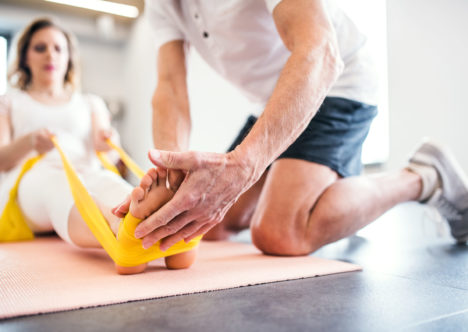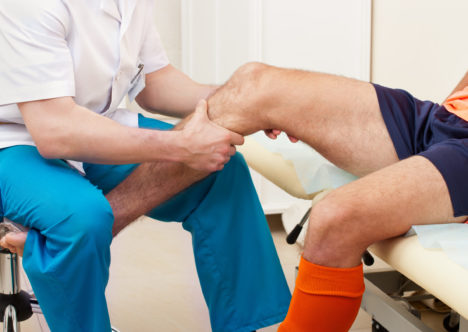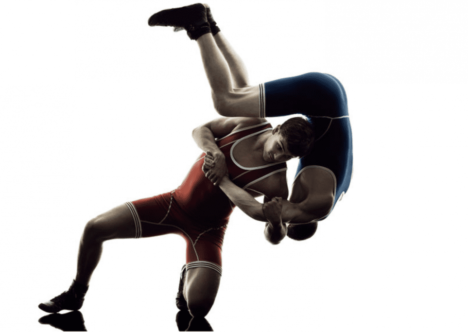Use our convenient online scheduler to book an appointment now.

Nonoperative tennis elbow treatment is often misunderstood. This type of tennis elbow treatment is not designed to heal the problem but rather to “buy” time until the damaged tissue heals itself. In nonoperative tennis elbow treatment, our goal is to provide comfort, protection from further injury and rehabilitation to minimize future harm.
As you may recall from an earlier post, tennis elbow symptoms occur when the origin of a tendon on the outside of your elbow gets injured. This occurs from either overuse or direct trauma. This problem can often resolve without surgery. However, if the injured tendon is unable to heal, then the symptoms will often persist until the damaged tissue is surgically removed.
This post will review the nonoperative approach to tennis elbow treatment. Let’s take a look:
Tennis Elbow Treatment: Nonoperative Approach
- Protection
- Symptom Reduction
- Rehabilitation
Protection
Protection is a critical component of tennis elbow treatment. Most often tennis elbow develops during middle age. As we age, the speed at which we heal slows. Our ability to heal is essentially a race between how quickly we heal and how much further damage the injured tissue sustains. The exact speed at which we will heal is unknown. So by limiting further damage, we have a better chance of winning this “race”. As a result, I often recommend two things:
- Avoid lifting with your palm facing down (and any other painful activities) – The tendons injured with tennis elbow are used when you lift things with your palm facing the floor. By avoiding these and other painful activities, you reduce the risk of further injury.
- Tennis elbow band – These are the small bands you’ve probably seen being worn on people’s upper forearm. They are designed to alter the force distribution among the elbow tendons. They try to increase the force on your healthy tendons and “unload” your damaged ones. It’s not perfect and it won’t work for everyone, but it is simple, not terribly expensive and so usually worth a try.
Symptom Reduction
Also very important. After all, it’s usually pain that brings you to the doctor. Tennis elbow sometimes can be very painful. Some people have “nagging” pain around the clock. If your symptoms are this severe, you may not be able to sleep, work, participate in your recreational activities or your rehab. You will not be able to give the time needed to heal this problem. Your tennis elbow treatment needs to address this. There are a number of techniques I use.
- Ice – It numbs the area and it can help reduce associated pain producing inflammation. Although the primary issue of tennis elbow is damaged tendon tissue, there is an inflammatory response that causes swelling and pain. Ice can help limit this.
- Massage – Friction massage can help increase local blood flow to promote healing and it may reduce painful soft tissue swelling.
- Anti-inflammatory Medication – Somewhat controversial. After all, the early stages of healing are inflammatory. So why would we want to diminish it? Several reasons – First, everything in medicine is a balance of risk vs benefit. To me, the benefits often outweigh the risks. Rarely when someone comes to me are we in the “early stages” of healing. Usually the healing process has been disrupted and prolonged. This is not the same healing mimicked in lab experiments. Secondly, you came for help. You are in pain. Perhaps you’re unable to work. You surely can’t enjoy your leisure activities. If your pain is lessened, you will likely be more positive about your recovery potential. You will be able to participate in effective physical therapy. By reducing your pain, we may be able to buy the time needed for the damage to heal.
- Pain Medications – I rarely use these and if so only on a short-term basis. I think that the risk vs benefit analysis does not favor their regular usage.
- Steroid (Cortisone) Injection – Somewhat controversial as well. Injectable steroids are very strong anti-inflammatories and by being injected at the site of the problem, their effect is much stronger than that of the oral medications. They have also been shown to cause tissue breakdown, when used frequently. As a result, excessive use can cause destruction of some very important ligaments near the area of your damaged tendons. With that said, because of their excellent ability to reduce pain, I will use them judiciously in some patients.
- Physical Therapy Modalities – Your therapist has many tricks up their sleeve. Among them are methods that reduce pain, swelling and some that may potentially increase the blood flow to the area of tissue damage. For these reasons and others, I almost always incorporate PT into my tennis elbow treatment plan.
Rehabilitation
This is an often overlooked component of tennis elbow treatment. I frequently see patients who feel better, fail to rehabilitate their elbow, resume their activities and then “re-injure” their elbow and get recurrent symptoms. Your symptoms began because the injured tendons were unable to withstand the forces applied to them. Essentially, the activities you performed required greater elbow “conditioning” than your elbow had. After a period of injury and rest, your elbow tendons likely have become even weaker, stiffer and have less endurance than before the injury. If the elbow wasn’t in shape to perform your pre-injury activities, it surely won’t be in shape to perform these same activities after you recover unless rehabilitated. For this reason, I think PT is a critical component of tennis elbow treatment.
A Word About “Regenerative” Treatments
In the ideal world, our tennis elbow treatment would also involve methods to stimulate healing. It turns out that such treatments may exist. There are several substances being used for this purpose. PRP (Platelet Rich Plasma) and stem cells are two of the more common ones that you may hear about.
Their effect is controversial and we are in our infancy of understanding them. However, there is some evidence that they may have a beneficial effect. These substances come from your own tissues. PRP comes from your blood. Stem cells may come from your blood, fat or bone marrow. Both potentially contain “growth factors” that may stimulate healing. A needle or other minimally invasive technique is required to obtain the material. An injection is needed to administer the substances. Neither of them have been shown to cure all cases. Both have shown some benefit when compared to other treatments. Unfortunately, due to the controversy surrounding these substances, their use is not routinely covered by most health insurance policies.
There you have it, the nonoperative approach to tennis elbow treatment. Follow these recommendations and you have a very good chance of avoiding surgery. But should the tissue not heal and your symptoms not improve, surgery will be needed to resolve your problem. Fortunately, there are a number of very good techniques with good success should that be needed. I’ll discuss that in a future post.
Join our Mailing List
TCO provides patients with orthopedic problems the trusted resources and patient-centered advice they need to “Feel Better. Move Better. Be Better.”
© 2024 Town Center Orthopaedics | All Rights Reserved


